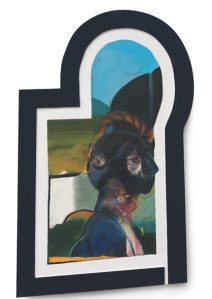
La Quatrième Poupée Radiante
The exhibition title references Barnett Newman’s painting of the same name, a high point of Modernist art, which in 1986 was slashed with a box-cutter and irreparably destroyed while it hung in Amsterdam’s Stedelijk Museum. Bremer’s new works, literally scratching into the surfaces of Modernist masters, engages with this legacy of destruction, yet the artist uses his cutting technique as a means of entering into and engaging with the original paintings and photographs. Rather than functioning as critique, the works inhabit the lines and brushstrokes of past artists in order to make something new, bridging the boundaries of style and time.
In this new body of work, Bremer uses his signature technique of painting on his own photographs of his own, but he also experiments with new approaches, both in the images in which he interferes and in the methods he employs. Collages in the broadest sense, the new works feature a broader variety of tools, media and artistic references.
Bremer has digitally layered and blended images of nudes and studio interiors by Brandt and Brassaï, bits of paintings by Picasso and Matisse, and his own personal photographs. On these collages, Bremer has employed pen, paint, ink and knife, slicing through the emulsion while the drawn and painted marks squeeze themselves into the works.
A Brandt nude, for instance, merges with the faces of two women painted by Picasso; overlaid with ink and knife cuts, the composite woman exudes power, reminiscent of the goddess Isis and the Venus of Willendorf. Bremer’s mark-making collapses the borders between his various source images, suturing together multiple layers, styles, and modes of expression.
Resource : http://sebastiaanbremer.com/exhibitions/whos-afraid-of-red-yellow-and-blue/exhibition-images/



